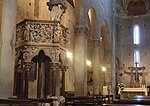Palazzo Marchetti, Pistoia
Houses completed in the 17th centuryPalaces in Pistoia

The Palazzo Marchetti is a Baroque-style palace located at Via Curtatone e Montanara in central Pistoia, Tuscany, Italy. The palace, which once served as a civic art gallery, is used in 2019 as a civic archive for various family collections of documents.
Excerpt from the Wikipedia article Palazzo Marchetti, Pistoia (License: CC BY-SA 3.0, Authors, Images).Palazzo Marchetti, Pistoia
Via Curtatone e Montanara, Pistoia
Geographical coordinates (GPS) Address Nearby Places Show on map
Geographical coordinates (GPS)
| Latitude | Longitude |
|---|---|
| N 43.934456 ° | E 10.914132 ° |
Address
Palazzo Ganucci Cancellieri
Via Curtatone e Montanara 51
51100 Pistoia
Tuscany, Italy
Open on Google Maps











